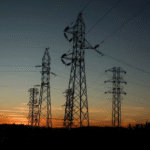Energy News Beat
Across the United States, soaring electricity bills are igniting political debates, with voters and policymakers pointing fingers at state energy policies, infrastructure challenges, and federal decisions. As energy costs outpace inflation, the issue is poised to influence the 2026 U.S. midterm elections, particularly in states where residents face the highest power prices. This article examines the states driving the energy cost dilemma, their electricity generation mixes, the factors behind rising bills, and the potential electoral fallout.
When high energy prices occur, several outcomes emerge, all of which are interconnected. Deindustrialization, regime change, and financial collapse all can be traced to high energy prices and Net Zero or climate change energy policies. We are watching all of this play out in the UK and the EU in real time.
The States with the Highest Electricity Prices
According to the U.S. Energy Information Administration (EIA), residential electricity prices have risen 13% on average since 2022, outpacing inflation. However, certain states—often those with aggressive clean energy mandates or strained grids—face significantly higher costs. The five states with the highest residential electricity prices in 2024, based on EIA data, are:
-
Hawaii: 42.67 cents per kilowatt-hour (kWh)
-
California: 29.24 cents/kWh
-
Massachusetts: 28.47 cents/kWh
-
Rhode Island: 27.39 cents/kWh
-
Connecticut: 26.94 cents/kWh
These states stand out due to their reliance on specific energy mixes, high infrastructure costs, and regulatory frameworks that prioritize renewable energy transitions. Below, we explore the electricity generation mix for each state, drawn from EIA’s 2023 data, to understand the drivers of their high prices.
Electricity Generation Mix in High-Cost States
The energy mix—the proportion of electricity generated from sources like natural gas, renewables, coal, nuclear, and others—plays a critical role in determining electricity costs. States with heavy reliance on imported fuels, intermittent renewables, or aging infrastructure often face higher prices. Below is a breakdown of the 2023 electricity generation mix for the top five high-cost states, based on EIA’s Electric Power Monthly data.
|
State
|
Natural Gas (%)
|
Nuclear (%)
|
Renewables (%)
|
Coal (%)
|
Other (%)
|
Avg. Price (cents/kWh, 2024)
|
|---|---|---|---|---|---|---|
|
Hawaii
|
0.0
|
0.0
|
18.3 (Solar: 10.2, Wind: 4.5, Hydro: 1.0, Biomass: 2.6)
|
13.7
|
68.0 (Petroleum)
|
42.67
|
|
California
|
43.1
|
8.6
|
41.3 (Solar: 18.5, Hydro: 12.0, Wind: 7.8, Geothermal: 2.4, Biomass: 0.6)
|
0.0
|
7.0
|
29.24
|
|
Massachusetts
|
63.0
|
0.0
|
17.0 (Solar: 9.0, Wind: 2.5, Hydro: 2.5, Biomass: 3.0)
|
0.0
|
20.0 (Imported)
|
28.47
|
|
Rhode Island
|
92.0
|
0.0
|
7.0 (Solar: 5.0, Wind: 1.5, Biomass: 0.5)
|
0.0
|
1.0
|
27.39
|
|
Connecticut
|
54.0
|
38.0
|
6.0 (Solar: 3.5, Hydro: 1.0, Biomass: 1.5)
|
0.0
|
2.0
|
26.94
|

Why Are Prices So High in These States?
-
Hawaii: The state’s astronomical prices stem from its heavy reliance on imported petroleum (68% of electricity generation), as it lacks domestic fossil fuel resources. Limited land for large-scale renewables and high transmission costs across islands exacerbate the issue. Hawaii’s push for 100% renewable energy by 2045 adds regulatory costs, though solar adoption is growing.
-
California: High prices are driven by investments in wildfire prevention, grid upgrades, and a rapid transition to renewables (41.3% of generation). The state’s deregulated energy market and reliance on natural gas (43.1%) expose consumers to volatile fuel prices. The volatile fuel prices are a result of the state’s decision to shut down oil and gas exploration, which is harming the industry through excessive regulation. Also, their water management in California has been a total disaster, and they could have avoided lots of problems with even marginally good policies around the hydro dams. Policies like the cap-and-trade program increase costs for fossil fuel-based generation, passed on to consumers.
-
Massachusetts: The state’s high natural gas reliance (63%) ties prices to fluctuating global markets, especially after the 2022 Ukraine invasion spiked gas prices. Limited local generation and imports (20%) add costs, while renewable mandates under the Climate Roadmap Act increase short-term expenses for grid integration.
-
Rhode Island: Near-total dependence on natural gas (92%) makes the state vulnerable to price spikes. Limited renewable capacity (7%) and high distribution costs in a small, dense state contribute to elevated rates. The state’s Renewable Portfolio Standard (RPS) mandates further increases in costs.
-
Connecticut: Despite a significant nuclear contribution (38%), high natural gas use (54%), and limited renewables (6%) drive costs. Aging infrastructure and regional grid constraints in New England, coupled with clean energy mandates, push prices higher.
Common Factors:
-
Renewable Mandates: States with aggressive RPS or net-zero goals (e.g., California’s 70% renewables by 2030, Massachusetts’ 100% clean energy by 2050) face higher short-term costs for grid upgrades and energy storage to manage intermittent solar and wind.
-
Natural Gas Volatility: Post-2022 gas price spikes, driven by global demand and U.S. LNG exports, hit states like Rhode Island and Massachusetts hard.
-
Infrastructure Costs: Aging grids, wildfire mitigation (California), and storm resilience (New England) require billions in investments, passed to consumers via rate hikes.
-
Data Center Boom: Surging electricity demand from AI-driven data centers, particularly in California and New England, strains grids and raises prices.
Political Heat: Energy Costs and the 2026 Midterms
Rising power bills are becoming a political lightning rod, with both parties leveraging the issue to sway voters ahead of the 2026 midterms. The electoral fallout could reshape energy policy, particularly in high-cost states with competitive races.
Republican Strategy
Republicans, led by figures like President Donald Trump, have seized on high electricity prices to criticize Democratic clean energy policies. Trump’s 2024 campaign promised to halve energy costs, blaming “blue state” renewable mandates for price spikes. Key arguments include:
-
Renewable Costs: GOP candidates argue that wind and solar mandates increase bills due to storage needs and grid upgrades, citing states like California and Massachusetts.
-
Fossil Fuel Advocacy: Republicans push for expanded natural gas and oil production to lower costs, with Trump’s executive orders targeting EV mandates and IRA clean energy subsidies.
-
Voter Anger: In states like Ohio, where rates are rising 26% due to data center demand, Republicans are framing Democrats as out-of-touch with working families.
Competitive 2026 races in states like Pennsylvania (Senate) and Arizona (House) could see Republicans gain traction by promising deregulation and fossil fuel expansion, especially in areas hit by recent rate hikes.
Democratic Strategy
Democrats counter that clean energy investments will stabilize prices long-term by reducing reliance on volatile fossil fuels. They highlight the Inflation Reduction Act’s (IRA) $9 billion in consumer rebates and tax credits for renewables, though these have been slow to reach households. Key points:
-
Long-Term Savings: Democrats argue that renewables like solar (cheapest new power source) will lower costs, citing California’s solar boom (18.5% of generation).
-
Utility Reform: In blue states, Democrats are targeting utility profits, with proposals in New York and California to cap returns and refund clean energy program costs.
-
Climate Appeal: In liberal strongholds like Massachusetts, Democrats frame high costs as necessary for climate goals, appealing to environmentally conscious voters.
However, Democrats face challenges in competitive states like Nevada and Wisconsin, where voters prioritize affordability over climate goals. Failure to deliver tangible bill relief could cost seats.
Potential Electoral Fallout
-
High-Cost States: In California, Massachusetts, and Connecticut, Democratic dominance may cushion losses, but voter frustration could boost GOP turnout in suburban House districts. Rhode Island’s small size limits its electoral impact, but rising bills could hurt Democratic incumbents in tight races.
-
Swing States: States like Pennsylvania, with moderate price increases (13.5 cents/kWh) but looming PJM capacity price hikes (up 833% in 2025 auctions), are critical. Republicans could gain Senate and House seats by blaming Democratic energy policies.
-
Rural vs. Urban Divide: Rural voters, hit harder by fixed utility costs, may swing Republican, while urban voters in blue states may tolerate higher bills for climate progress.
-
Policy Shifts: A Republican sweep could lead to IRA repeals, slashing clean energy credits and raising bills by $110/year per household by 2026. A Democratic hold might accelerate renewable subsidies but risk short-term rate hikes.
Broader Fallout from High Energy Prices
Beyond elections, sustained high energy prices could have cascading effects:
-
Economic Strain: Households face increased financial burdens, with low-income families spending up to 8% of income on energy. Small businesses, especially in manufacturing-heavy states like Ohio, may cut jobs or raise prices.
-
Grid Reliability Risks: Underinvestment in baseload power (e.g., nuclear, natural gas) amid renewable transitions could lead to blackouts, as warned by NERC, particularly in New England and California.
- We have been
-
Clean Energy Slowdown: If voters reject high costs, states may scale back RPS mandates, delaying climate goals. Conversely, sustained high gas prices could accelerate solar and wind adoption.
-
Industrial Competitiveness: High electricity costs could drive data centers and manufacturers to low-cost states like Texas (10.5 cents/kWh), shifting economic growth.
Conclusion
The surge in U.S. power bills, driven by states like Hawaii, California, and Massachusetts, reflects a complex interplay of energy mixes, regulatory mandates, and infrastructure challenges. While these states push for renewables, their reliance on volatile natural gas and costly grid upgrades fuels voter discontent. As the 2026 midterms approach, energy costs will be a pivotal issue, with Republicans criticizing clean energy policies and Democrats defending the long-term climate benefits that have yet to materialize.
Our current leadership in the Department of Energy is on the right track in seeking to approve energy sources that can generate more energy than it takes to create them, and their push for Energy Dominance is well-targeted. That being said, there is a lot of work to be done in preparation for defending the House and Senate seats in the midterm election. As we have written in several articles, numerous renewable energy projects in Republican-held areas should not be connected to the grid, as they will add costs to consumers without increasing grid resilience. However, they will be pushed through to garner some votes, even though they may not be beneficial to the local communities.
The key is to get involved locally, as we are seeing more and more communities starting to take note and have an impact on their energy sources and utilities. Robert Bryce on his Substack has been tracking the number of communities that are getting involved and getting projects canceled. The time is now to take your communities back from the Net Zero movement to higher energy costs. The outcome could significantly reshape U.S. energy policy, striking a balance between affordability and sustainability in a politically charged landscape.
Is Oil & Gas Right for Your Portfolio?
Crude Oil, LNG, Jet Fuel price quote
Sources:
-
U.S. Energy Information Administration (EIA): Electric Power Monthly (2023), Average Retail Price of Electricity (2024)
-
Additional references as cited in the text.
The post Rising U.S. Power Bills Sparking Political Heat: Which States Are Causing the Dilemma? appeared first on Energy News Beat.








